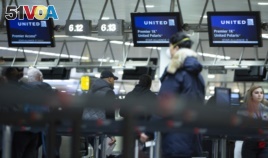12 May 2020
Every once in a while, pictures or videos of airplanes nearly full of passengers appear on social media. That seems to violate advice from public health officials related to social distancing during the coronavirus crisis.
Some people have raised the question: How can airplanes still be full when air travel has decreased more than 90 percent from a year ago?
In some cases, airlines are creating the crowds. They are canceling flights. Passengers must then crowd onto the few remaining planes.
The airlines, however, say that they are taking action to ease passengers' fears about coronavirus contagion. Some are blocking middle seats — or letting passengers pay extra to guarantee an empty seat next to them. They are also starting to require passengers to wear facial coverings.
People are still flying
The number of people traveling on airplanes is at its lowest level in many years. There are only about 17 passengers on the average flight within the United States. But that is an average.
The number of people passing through airport security has been rising since the middle of April, but it is still down 93 percent from one year ago.
So, why are some flights full?
Partly, it is because of the high number of canceled flights.
On routes where there used to be several flights offered by different airlines, now there may be two or three, said Robert Mann. He is a former airline official in the New York area.
Airlines have sharply cut their flight offerings. They also cancel flights in the few days before departure. That can force passengers who were scheduled to be on many different flights to be on the same one.
Some planes are more likely to be crowded, especially those between hub airports operated by the same airline.
Another question is whether airlines are spacing passengers out.
Several airlines are blocking some middle seats. Delta Air Lines, for example, said recently that it will block some window and aisle seats until June 30. This will leave 50 percent of first class and 60 percent of the main area empty. Southwest chief Gary Kelly said his airline will temporarily limit the number of seats it sells, probably to 67 percent.
Frontier Airlines said that, until August 31, it will guarantee passengers an empty aisle seat next to them — if they pay between $39 and $89.

A man wears a protective mask as he waits to check into a flight to the United States in the main terminal of Brussels International Airport in Brussels, Friday, March 13, 2020.
Covering your face
What about face coverings?
All the leading U.S. airlines have announced plans to start requiring passengers to wear face coverings on flights. JetBlue Airways was the first to announce the policy, which took effect May 4. Recently, Delta, American, United and Southwest have also made it a requirement.
Airlines say they will not let passengers board a plane without masks. But, small children and people with some medical conditions will generally not have to wear them. Others will be permitted to briefly remove coverings while eating or drinking.
Flight crews are preparing for passengers who will ignore the rules.
An industry official told The Associated Press that airlines would not land planes if a person will not keep their face covering on "unless they are violent or crazy." The official asked not to be named since he was not permitted to discuss the airline's operations with reporters.
In addition, the airlines are requiring crew members to wear face coverings.
Cleaning procedures
How do airlines clean planes?
Every airline says it has increased cleaning of plane cabins to help prevent spread of the coronavirus. Some, like Delta, say they are using special machines to spread anti-viral chemicals.
Airlines say that the air inside their planes is safe to breathe. Cabin air on most large planes is a mix of fresh air from the outside and air that is passed through high-efficiency air filters.
Changes will remain
And finally, how long will the changes last?
Until there is a proven treatment or widely available vaccine for COVID-19, the changes are likely to stay in place for a time. COVID-19 is the disease caused by the coronavirus.
If more people start taking airplanes this summer, it is still not expected to be anything like the summer of 2019.
I'm Alice Bryant.
The Associated Press reported this story. Alice Bryant adapted it for Learning English. Mario Ritter, Jr. was the editor.
________________________________________________________________
Words in This Story
contagion –n. a disease that can be passed from one person to another by touching
pandemic –n. the fast spread of a disease to many people over a large geographical area
departure –n. the process of leaving a place to go on a trip
scheduled –adj. planed ahead of time
hub –n. an airport through which an airline sends most of its flights
aisle –n. a space to walk between rows of seats
cabin –n. the area in a passenger airplane where the passengers stay
filter –n. a device that removes unwanted substances from gasses like air or liquids like water